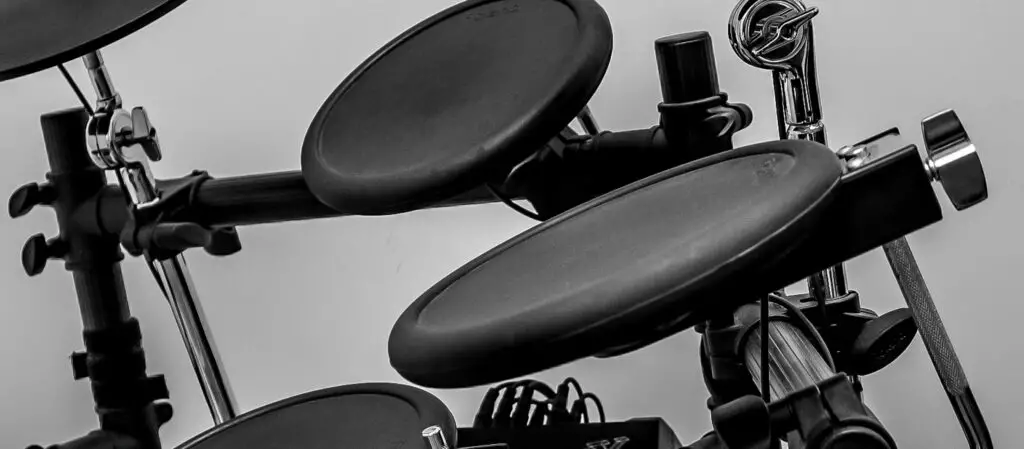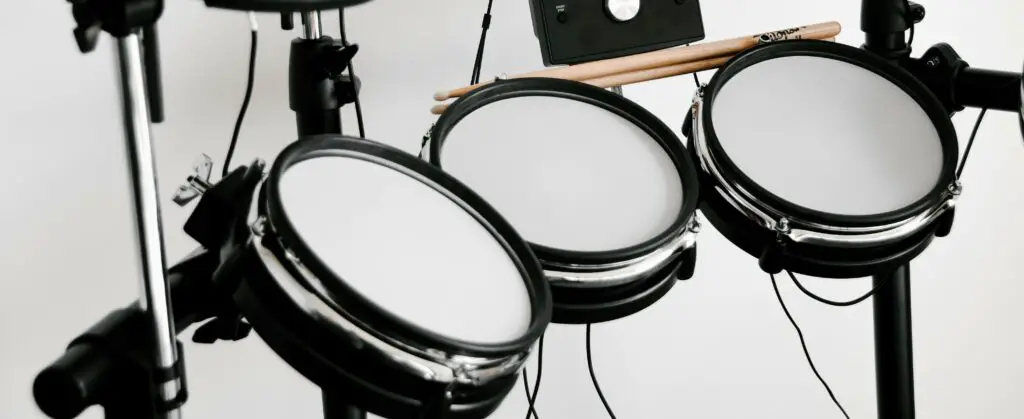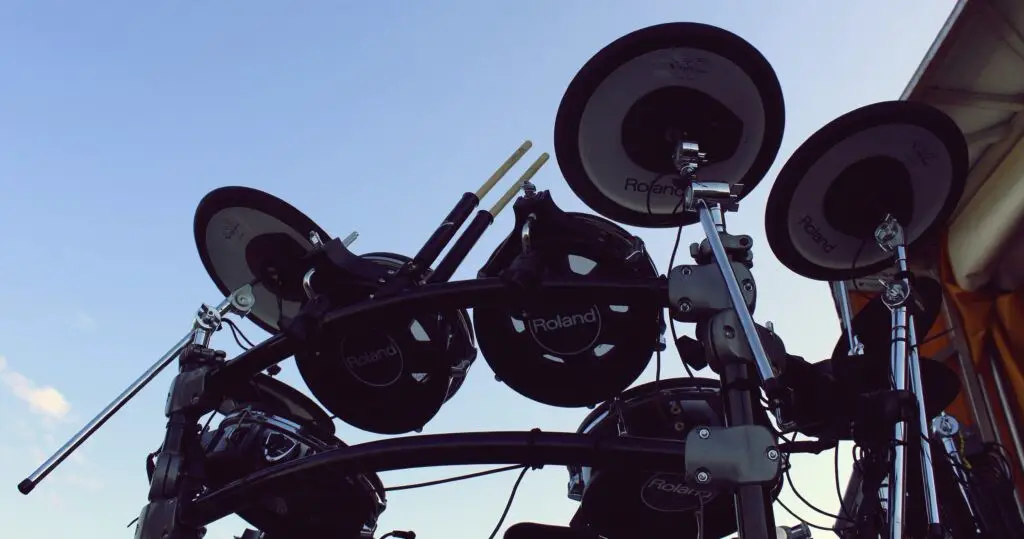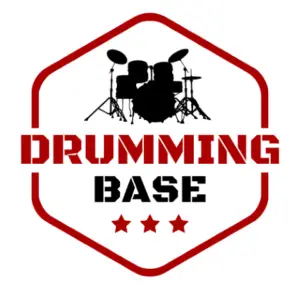If you’re a beginner buying their first drum kit, one of the first things you’ll need to decide is if you want to go with an electronic set, or an acoustic set.
Electronic drum kits are typically better for beginners than acoustic drum kits because they can be played at lower volumes, are cheaper, take up less space, are easier to set-up, and come with extra features to help new drummers learn more quickly.
The only main drawbacks of electronic drum kits are that they do not feel the same as acoustic kits, so can make it harder for beginners to transition in the future. However, plenty of drummers start off using E-drums and make the switch to acoustic drums later on without any real problems.
| Advantages of E-Drums | Disadvantages of E-Drums |
| Low ambient volume | The pads/ cymbals do not feel like acoustic kits |
| Do not take up much space | The pads/ cymbals are smaller |
| Cheaper than acoustic kits | They are less suitable for live performances |
| Easy to set up | There is little positioning flexibility |
| Have extra features e.g., metronome/ built-in tracks | Harder to transition to acoustic drums in the future |

Advantages of E-Drum Kits for Beginners
There are several advantages of getting an electronic drum kit if you are a beginner:
- They are quieter than acoustic drum kits
- They take up less space than acoustic drum kits
- They are cheaper than acoustic drum kits
- They have extra features to help beginners learn
- They are easy to set up
Low Volume
Electronic drum kits are significantly quieter than acoustic drum kits.
E-drums are around 60-65 dB (when not plugged in/ when using headphones), whereas acoustic drum sets are around 120 dB. For perspective, 60-65 dB is about the same volume as a normal conversation, whereas 120 dB is about the same as a chainsaw.
If you plan on playing your drum set at home (like most beginners do) and have any neighbours or housemates, an electronic drum kit is really the only practical option.
If you want to play your drum kit aloud, then you can use an amplifier still to get it to the same volume as an acoustic drum kit, so it’s not really limiting if you do want to increase the volume.
Although the ambient noise of an E-drums shouldn’t cause much of an issue in most cases, it’s still possible that people below you, or in an adjoining room may find it annoying. Luckily though, there are several ways to make them sound quieter. This is much more difficult to do with an acoustic kit.
Check out this article “how loud are E-drum kits” to learn more.
Space Saving
Another great benefit of an electronic drum set is that it takes up a lot less room than an acoustic set. Beginners will usually put their drum kits either in their bedroom or a spare room, so it’s always helpful if it doesn’t take up a tonne of space.
Most 5-piece acoustic drum kits require 75″ x 55″ of space, whereas electronic drum kits typically only require 50″ x 48″ of space. In other words, electronic drum kits take up about 40% less space on average compared to acoustic kits.
It’s also possible to get even more compact electronic drum kits which take up even less space if you want to neatly tuck it away in the corner.
Check out this article “how much space is needed for a drum kit” to learn more.
Less Expensive
If you’re a beginner buying your first drum set, then the chances are that you’ll not want to throw loads of money into your new hobby before you’re absolutely sure it’s something you want to do for years to come.
Electronic drum sets are much cheaper than acoustic drum sets, which makes them an excellent option for beginners who want to get started but without paying over the odds.
- Acoustic drum kits start at roughly $400 but you can expect to pay at least $600 for a good quality one
- Electronic drum kits start at approximately $200 but it’s recommended to get one that costs $400 or above to get a much better quality kit

Extra Features
Another huge benefit of electronic drum kits is that they’re packed with features to help you learn faster and get the most out of your kit.
Although the features vary between kits (typically the more you pay, the more features you’ll get), the most common ones are:
- Different kit sounds
- Built-in tracks
- Metronome
- Performance recorder
- Coaching mode
- Headphone/ stereo line outputs
- MP3 input
Uncomplicated Setup
If you’re only just beginner your drumming journey, then the likelihood is that you don’t want to get bogged down with tuning your drum heads or altering the position of your kit to get the best sound, you probably just want to get practicing and improving.
Electronic drum kits are super easy to assemble and play without having to worry about all the added complications that acoustic drum kits come with. This is a huge benefit if you’re a beginner, as it can be quite overwhelming to get to grips with.
Disadvantages of Electronic Drum Kits
It’s not all sunshine and rainbows though, there are some notable disadvantages of electronic drum kits compared to acoustic sets. Although I still think E-drums are the absolute best way to go for beginners, you still need to be aware that there are some drawbacks:
- Electronic drums don’t feel the same as acoustic drums
- The drum pads and cymbals are smaller
- They aren’t as suitable for live performances
- They are much more limited in terms of positioning
They Feel Different to Acoustic Drums
There’s no doubt about it, electronic drums and cymbals do not feel the same as acoustic drums and cymbals. The rebound and feedback is very different, so it can make it harder to transition to an acoustic kit later on.
If you are concerned about this I’d recommend getting two features on your E-drum set:
- Mesh heads (instead of rubber)
- A kick tower (instead of just a pedal)
- Multi-zone pads
Mesh heads offer better rebound and feel more sensitive compared to rubber head, they also have a lower ambient volume. Check out this comparison between rubber and mesh heads to learn more.
Cheaper electronic drum kits only come with a kick pedal, instead of a tower and pad for the pedal to hit. Opting for the tower is a much better choice as it feels more like an acoustic kit.
On an acoustic drum kit, the sound of the drums and cymbals will alter depending on where they are hit. Although E-drums are good at recognising how hard the pads are hit, they are less sensitive in terms of the location.
Entry-level E-drums will usually have a single zone design, meaning the drum will sound exactly the same no matter where it’s hit. Better kits will have dual-zone cymbals and the snares, and the most premium will have zones on the toms.

Smaller Drums and Cymbals
Although electronic drums do save space, this comes at the price of having smaller drum pads and cymbals which again makes them feel like less acoustic kits and can be an issue when transitioning from E-drums to acoustic drums later on.
Having smaller pads can make the kits a bit harder to play as you need to be more precise, however some will see this as an advantage as it teaches you to be accurate.
On acoustic kits, the cymbals and drums are all different sizes, whereas on E-drum kits, the cymbals are typically all the same size, as are the drum pads. This can be slightly confusing as a beginner when learning how to use each type of drum.
| Component | Average Acoustic Kit Size | Average Electronic Kit Size | Size Difference |
| Hi-Hat Cymbal | 14″ | 10″ | 30% smaller |
| Ride Cymbal | 20″ | 10″ | 50% smaller |
| Crash Cymbal | 16″ | 10″ | 40% smaller |
| Snare Drum | 14″ | 8″ | 45% smaller |
| Rack Tom | 10″ | 8″ | 20% smaller |
| Floor Tom | 14″ | 8″ | 45% smaller |
Less Suitable for Playing Live
It’s rare to see an electronic drum kit being played in a live performance. Although it isn’t impossible (as you can use a drum amp or PA system), in a regular band you’re much more likely to see an acoustic kit. This is because they usually sound better, and it’s easier to make them louder.
It’s not too much of an issue for a beginner as they’re unlikely to be playing live for a good while, but it’s something to note for the future. You may need to borrow the venue’s kit (if they have one) if you plan on playing live.
Limited Positioning Flexibility
A notable drawback of E-drum sets is that they are quite limited in terms of the positioning of each drum and cymbal. Some more expensive kits will allow you to adjust the reach and rake of the pads to some degree, but cheaper ones are often fixed. This can make it more difficult to position the kit ergonomically to suit each drummer.
Acoustic kits on the other hand make it very easy to adjust the position of each component to suit the drummer’s preferred positioning.
It’s worth trying the E-drum kit in the store first to make sure it feels comfortable to you before purchasing it, as it may be impossible to positioning it ergonomically in some cases.

Tips for Buying a Beginner E-Drum Kit
Here are some of my favourite quick tips for buying an electronic drum kit to make sure you get the best playing experience:
- Choose mesh pads instead of rubber pads
- Try and choose a kit which has dual-zone cymbals and snare
- Get a kit with a kick tower instead of just a pedal
- Choose a kit by a respected brand (e.g. Roland, Yamaha or Alesis)
- Consider a used mid-range E-drum kit if you’re on a tighter budget instead of a new entry-level drum kit
Best Electronic Drum Kits for Beginners
Here are my top picks of electronic drum sets for beginners.
Best Budget Option: Alesis Turbo Mesh
- Good quality and well-respected brand
- 120 module sounds and 30-tracks
- Mesh drum pads
- Missing some features like a dual-zone snare and kick tower but still good for the money
Best Value for Money: Alesis Nitro Mesh
- Dual-zone snare
- Kick tower and pedal
- 385 module sounds and 60 tracks
- Expansion kit available
Check out this article comparing the Alesis Nitro Mesh and Turbo Mesh to learn more.
Best Quality: Roland TD-50KV2
- True acoustic drum and cymbal sizes
- Multi-sensor triggering
- Over 900 sounds
- Integrated effects e.g. EQ, reverb




